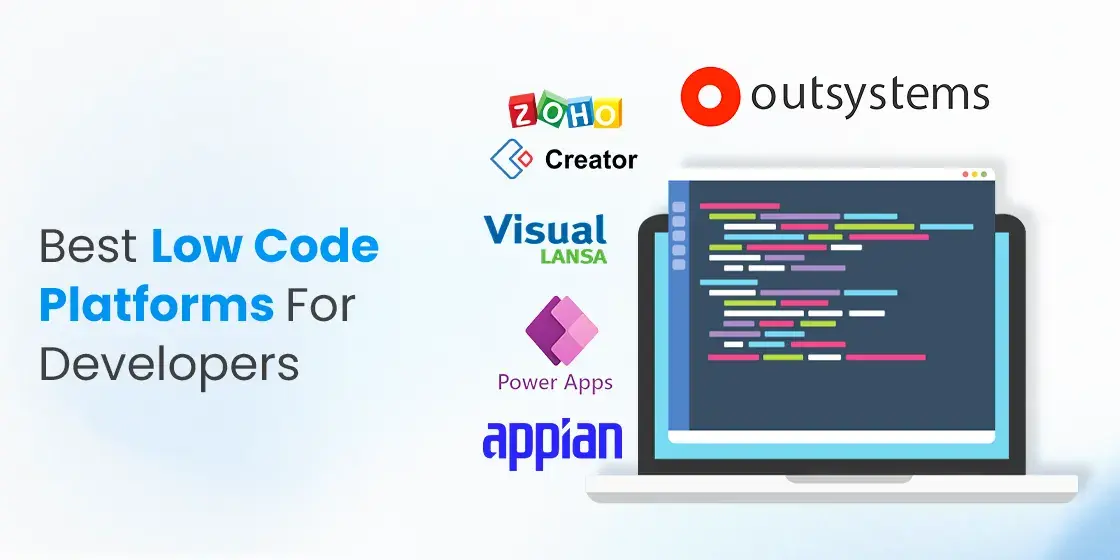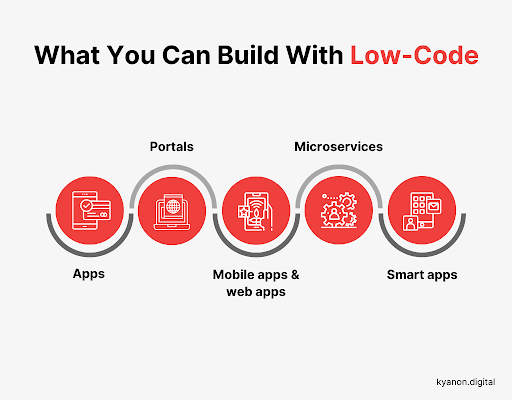Development of low-code applications significantly increases development speed because of several key factors: Visual Development Environment:
Drag-and-Drop Interfaces: Low-code platforms provide visual tools for designing applications. Developers can quickly assemble applications using drag-and-drop components without having to write code.
Pre-built components and templates A lot of low-code platforms have pre-built components and templates, which allows developers to rapidly prototype and create applications.
Reduced Coding Requirements for Coding:
Automated Generated Code: Lowcode platforms write the code base on the visual models created developers. This removes the need to write the code manually and speeds up the development process.
Reusable Parts: Developers will be able reuse reusable components across different projects, and cut down on the time needed for writing and testing of code.
Collaboration is made easier:
Integration of Development Tools: Low-code tools typically include tools for version control as well as testing and deployment that allow seamless collaboration between development teams.
Development by citizens: Using intuitive interfaces and reducing bottlenecks often caused by the insufficient availability of developers, business users and non-developers are able to contribute towards application development.
Rapid Iteration, Prototyping:
Rapid Prototyping: Developers design prototypes quickly to test concepts and get feedback. This leads to faster iteration cycles.
Easy Modifications: Low-code development is oriented towards visuals, which makes it easier to change and update applications. It also speeds the process of developing and improving applications in response to feedback from users.
Pre-built Integrations:
API Integrations. A lot of low-code platforms have connectors built for the most popular APIs and other services. This will make it easier to integrate systems.
Data Integration: Built-in tools for data integration facilitate the connection between databases and data sources. This speeds up development.
Deployment and Scaling:
Many low-code platforms have one-click options for deployment that reduces the amount of time and effort required to set up applications.
Cloud-Based Platforms: Cloud-based platforms that are low-code allow for the management of infrastructure and scaling, so developers can concentrate on the the logic and performance of their applications rather than deployment logistics.
Low-code development of applications is a quicker method to create applications. It makes it easier and more efficient to automate many elements of the process. This enables faster delivery and adapting to changing requirements. See the top rated Low-code Platform for application development examples for more advice including rad application development, software for app development, microsoft azure sql, cross platform mobile dev, push notifications android, build a docker container, cross platform mobile development, push alerts, app modernisation, rapid action development and more.

Low-Code Applications Are Cost-Effective.
Low-code development can bring many benefits in terms of cost efficiency. This makes it a good option for companies looking to optimize their development budgets, but providing high-quality applications. These are the main advantages: Lower development costs:
Lower Coding Requirements: Low Coding platforms remove the need to write code manually, saving developers both time and money. This means less labor costs.
We need fewer resources for developers. Programming low-code is faster and easier which means that fewer developers with specialized skills are needed. It could reduce the costs of staffing and hiring.
Faster time to market
Accelerated cycle of development: Visual development tools and pre-built components offered by platforms with low-code enable rapid application development, allowing companies to get their products on the market faster. This can lead faster revenue growth and improve competitive positioning.
Rapid prototyping. By rapidly creating and testing prototypes, companies can reduce time spent on development and improve their product faster based upon user feedback.
Lower maintenance costs:
The modular structure and standard components of applications developed with low-code platforms makes them simpler to maintain. This will reduce the cost of maintenance and ongoing support.
Automated Updates. Many low-code platform handle updates and patches automatically. Applications remain safe without needing extensive manual input.
Efficient Resource Utilization:
Non-Developer Contributions: Low-code platforms enable business users and other non-developers to take part in the development process. This allows companies to benefit from the talents of a broader range of employees, while reducing dependence on developers who are highly paid.
Utilizing IT resources efficiently: IT departments will be able to concentrate on strategic initiatives, instead of getting bogged down by mundane development tasks. This will boost overall efficiency and productivity.
Scalable pricing models:
Subscription Pricing: Many platforms with low-code offer different pricing options based on subscriptions that can be scaled in accordance with the amount of usage. This gives businesses the capability to match their spending to the growth of their business and its needs without the need for large upfront costs.
Pay-Assosiated Options: Some platforms provide pay-assosiated choices. They ensure that businesses pay only for the resources used, which is beneficial to entrepreneurs and small businesses that have limited resources.
Costs of Third-Party Software reduced:
Built-in Functionalities : A low-code platform typically comes with built-in functions and integrations, which eliminates the requirement for third-party software, tools and licenses.
Integrations pre-built: These systems and services integrate with popular services, which eliminates the requirement for custom-designed software, which saves time and cost.
Improved ROI:
Increased Return on Investment: Combining rapid development with less expense and a shorter speed to market, businesses will see a greater return on investments (ROI).
Enhanced Ability. Businesses can quickly adapt market changes and customer requirements and ensure that they remain relevant. They also can take advantage of new business opportunities as they come up.
Training costs are cheaper:
User-friendly interfaces: Low-code systems have intuitive and user friendly interfaces that cut down on the learning curve. They also eliminate the requirement for lengthy training programs.
Accessible Resources A lot of low-code platforms provide complete training materials, tutorials, and community support, further cutting the need for formal training and the associated expenses.
Collaboration can be streamlined.
Enhanced collaboration Tools Collaboration tools are integrated into the workflow. This allows for better communication between team members as well as the reduction of project overhead.
Unified Development Environment. An unified development platform reduces expenses and improve workflows by reducing the complexities of managing various tools.
The cost-effectiveness in low-code app development lies in its ability to reduce maintenance and development expenses, speed up the time to market, improve resources, and offer different pricing options. This combination of factors offers firms significant financial benefits which makes Low-code a desirable option for companies seeking to maximize development budgets, yet still creating robust and scalable applications. See the best https://www.wavemaker.com/low-code-enterprise-application-development-platform/ for site recommendations including build with docker, cross platform app dev, app platforms, application modernization, push alerts, cross platform mobile development, application modernisation, low code platforms, app platforms, cloud software applications and more.

The Benefits Of Developing Applications Using Low-Code For Collaboration And Workflow
Low-code applications offer a number of advantages in terms of workflow and collaboration, making it the perfect choice for businesses who want to increase team productivity and streamlining the development process. Here are a few of the most important benefits: Improved cross-functional collaboration:
Unified Development Environment: Low-code platforms offer a unified, single environment where team members comprising business analysts, developers designers, and others can work efficiently. This helps eliminate barriers.
Visual Development Tools - The drag-and-drop visual nature of low-code platforms allows people who are not technical to participate easily in the process. This makes sure that the requirements of business are accurately analyzed and implemented.
Communication Enhanced:
Real-Time Collaborative Features: Many platforms using low-code provide real-time collaborative capabilities, which include comments, editing, and instant feedback. These features facilitate communication and reduce time spent in back and forth conversations.
Shared Workspaces: Teams may collaborate in shared workspaces which allows them to view, edit and discuss project components, ensuring everyone's on the same page, and working towards common goals.
A streamlined workflow management system:
Integrated Project Management Tools: A lot of low-code software platforms include integrated tools for managing projects which can assist teams to track and manage their projects for development. This includes task assignment as well as monitoring progress and management of deadlines.
Workflow Automation: Automation of repetitive tasks and workflows can reduce manual effort and errors, allowing teams to focus on more strategic tasks and increasing overall efficiency.
More frequent iteration cycles:
Rapid prototyping: Low-code platforms allow for rapid prototyping, iterative development and quick prototyping. This allows teams to develop applications to test and improve them in shorter cycles. This allows feedback to be incorporated quickly into the application, and for rapid improvement.
Agile Development Support Supporting agile methods allows teams and individuals to work in smaller increments. This also makes it possible to quickly adapt to changes.
Accessibility for non-developers
Citizen Development: Low code platforms allow business users (citizens developers) to create and modify their applications without extensive knowledge of coding. This frees IT and Development teams of burdens and gives them the ability to respond faster to business requirements.
Training and Onboarding Intuitive interfaces and comprehensive training materials make it easy for new team members to become familiar with the team improving the overall teamwork within the team.
Centralized Documentation & Knowledge Sharing
Integrated documentation: Low-code platform features often allow you to create and manage documents on the platform. All information about your project is centrally accessible and easy to access.
Knowledge Repositories: Teams may build and maintain knowledge repositories that include best practices, templates, and reuseable components, helping to facilitate sharing of knowledge and reducing the repetition of efforts.
Consistency in Standardization
Standardized Components. Utilizing standard components that are pre-built allows for uniformity across all applications. This helps team members be able to work with the various parts of projects.
Governance and compliance: Integrated governance frameworks help ensure that development adheres to the requirements of regulatory standards and organizational standards. This lowers the risk of noncompliance, and helps applications comply with quality standards.
Feedback Loops and Improvement Loops
Integrated Feedback Mechanisms - Low-code platforms are often equipped with integrated feedback mechanisms. These enable users to give instant feedback on applications, which can then be integrated into the process of development.
Continuous Improvement: The capacity to rapidly test and deploy changes based on feedback assures continuous improvement of applications that are in line to the requirements of the users and business goals.
Visualization of Reporting
Real-time analytics The built-in analytical and reporting tools provide real-time information about the performance of your project, its progress and user interaction. They facilitate the use of data to make informed decisions.
Visual Workflow Analysis: Visual tools are used to visualize workflows and processes. These tools assist teams identify and improve their workflows.
Low-code application development has many benefits for collaboration and workflow. These include the ability to bring diverse teams into one location, improve communication, and automate certain processes. This creates a more collaborative atmosphere that is agile and efficient in its development process, resulting in more high-quality apps as well as a more effective alignment between the business goals.
